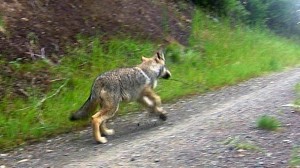The US Fish and Wildlife Service just release the following press statement about the independent Peer review (see link at bottom of  page):
page):
Service Reopens Comment Period on Wolf Proposal
Independent scientific peer review report available for public review
Following receipt of an independent scientific peer review, the U.S. Fish and Wildlife Service is reopening the comment period on its proposal to list the Mexican wolf as an endangered subspecies and remove the gray wolf from the Endangered Species List. The Service is making that report available for public review, and, beginning Monday, February 10, interested stakeholders will have an additional 45 days to provide information that may be helpful to the Service in making a final determination on the proposal.
The independent scientific peer review was hosted and managed by the National Center for Ecological Analysis and Synthesis (NCEAS), a highly respected interdisciplinary research center at the University of California – Santa Barbara. At the Service’s request, NCEAS sponsored and conducted a peer review of the science underlying the Service’s proposal.
“Peer review is an important step in our efforts to assure that the final decision on our proposal to delist the wolf is based on the best available scientific and technical information,” said Service Director Dan Ashe. “We thank the National Center for Ecological Analysis and Synthesis for conducting a transparent, objective and well-documented process. We are incorporating the peer review report into the public record for the proposed rulemaking, and accordingly, reopening the public comment period to provide the public with the opportunity for input.”
The peer review report is available online, along with instructions on how to provide comment and comprehensive links relating to the proposal, at www.fws.gov/home/wolfrecovery.
The Service intends that any final action resulting from this proposed rule will be based on the best available information. Comments and materials we receive, as well as some of the supporting documentation used in preparing this proposed rule, are available for public inspection at www.regulations.gov under the docket number FWS–HQ–ES–2013–0073.
The Service will post all comments on www.regulations.gov. This generally means the agency will post any personal information provided through the process. The Service is not able to accept email or faxes. Comments must be received by midnight on March 27.
The Federal Register publication of this notice is available online at www.fws.gov/policy/frsystem/default.cfm by clicking on the 2014 Proposed Rules under Endangered and Threatened Wildlife and Plants.
The Service expects to make final determination on the proposal by the end of 2014.
The U.S. Fish and Wildlife Service works with others to conserve, protect, and enhance fish, wildlife, plants, and their habitats for the continuing benefit of the American people. For more information, visit www.fws.gov, or connect with us through any of these social media channels:
– FWS –

Gray wolves along with other predators out of balance ARE drastically hurting our elk and deer numbers. We dont' need fish n Game to study that, we in the feild are seeing it for ourselves.
Tina, Amazing that is basically what the US FWS said: We do not need science. Unfortunately, the Endangered Species Act requires them to adhere to the best available science. As to your claim about predators being out-of-balance every time that has been rigorously examined that thesis has been found wanting and that many,many other factors were involved.
Bob Ferris
Hey Tina,Who's WE. I am a deer and elk hunter and the Peer reviewed science i read shows that the wolf predation makes the ungulate gene pools stronger,resulting in healthier deer,elk and moose and a more vibrant,healthy ecosystem that is able to support a greater number of plant and animal species. Also, the Americans that have been hunting our deer and elk for the last 12,000 years learned a long time ago that without the wolf the deer, elk and buffalo would become weak and sickly,making thier numbers dwindle. It was not the wolf that drove the buffalo to near zero numbers. It was a two legged predator that had a need to kill and kill and kill until the buffalo was no more.